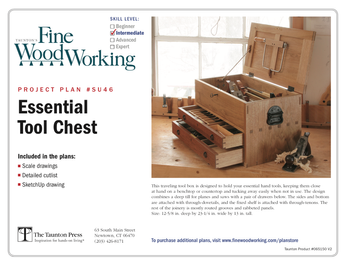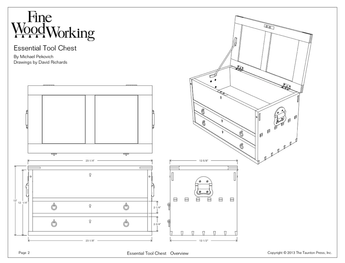Help- Panel door rails and stiles cracking when stained!
I had thought my technical skills had reached the next level until I heard and saw the stiles and rails on my mortise and tenon panel doors I was building crack while applying a coat of water-based dye this weekend. I built the panels with 2″ wide stiles and rails glued together and the panel is solid wood and floating (I left a 1/4″ gap all around the panel and used “space balls” to keep the panel from rattling). The panels have not cracked but some of my stiles and rails have in their centers which surprised me given that they are only 2″ wide hard maple.
When I entered my shop, it was 40-degrees. I turned on the heat which increased the temp to 60-degrees after two hours. Then I brushed on a water-based dye stain on the panel doors. I had to apply two coats in succession to even out the dark color of the dye. In the process I heard a few creaks and pops, not realizing till later that some of rails and stiles had some 3-5″ long cracks in their centers. I know wood expands due to temp and humidity but I never expected the rails and stiles to crack given their narrow width. I’m guessing it was the sudden change in temp combined with the water that rapidly changed the water content of the wood. Is this correct?
I promised my wife I’d build her new kitchen cabinets but I foresee a vote of no confidence when she sees the cracks. How can I prevent this from happening again in the future? Do I need to apply a sealer of shellac prior to the water based dye or not use water based dye in the winter, or keep my shop at 60-degrees for several days prior to applying the water based dye?
– Lyptus















Replies
crack problems
I have used water bourne finishes for over 20 years. I have tried water based stains and dyes and keep switching back to solvent based. I think the sudden temperature change and water application released tension already in your wood. One trick I did learn if you are going to use water based dyes is to wet your surface after sanding and let it dry,which will raise the grain. Re-sand and then stain and finish.
Maybe you could try alchol base stain. I always keep the shop at 60 degrees or more in the winter from the time I glue up a project until the finish is done. Glue drying and finishing don't mix with big swings in temperature or humidity in my opinion.
I have also found that flaws that were unseen despite careful inspection become quite obvious after stain or finish is applied.
I always make my frames 2 1/4 to 2 1/2 wide. Your panel sizing sounds good. I don't worry about the panel changing much in length, it's the width that will change with the seasons. A pin or tiny dab of glue centered top and bottom will keep the panel from shifting all the way to one side or the other.
Good luck. Stuff like this happens to us all.
Steve Duncan
Cabinetmaker since 1978
http://www.steveduncan.com
The key is to have the shop, wood and stain all at a minimum of 60 degrees. 70 is much better. It can take wood 6-12 hours to warm up from 40 to 60 degrees. Allow for the time.
Cracks
Could you post a photo ?
What was the wood source and how long was it in your shop before building the doors ?
SA
its the wood
I think the key is in your own statement. The panels did not crack but the stiles did. If you heard it crack thats another sign of some badly stressed wood. I'd take it back and complain if you got a lot of if take it all back. IMO temp only matters in the finishing side of things. Moisture is critical and wood moves but that's extreme. Especially if it was QS (what I use for all my rails/stiles). I work mostly in cherry and have found some wood with very small stress cracks that were so unusual I wanted to use them. I always take them down in phases and let them rest between each stage so it can rest. To finish I use cryocyclolate (superglue) to fill any small voids and it takes multiple passes and sometimes I start with the gel to build it up quicker and then sand flush and finish. Not had any issues. that works well with punky knots too. Either that wood came from the side of the hill, or the kiln operator made some mistakes.
The hard maple was kiln dried and I checked the moisture content throughout many of the boards and its been hovering around 8.5 this time of year in my shop. The rails and stiles were not quarter sawn but still, that shouldn't be necessary. I also dimensioned the rails and stiles in stages over the last few months. Planing on both sides and providing a few days to acclimate before dimensioning to final size and then a few more days prior to glue-up. I did not allow the panels time to adjust because when I did, they would warp slightly so I dimensioned them right before assembly so that the frame would keep them flat. The panel doors have been glued up for 3 months now so I was really surprised to see them crack.
Do you still think I just got some bad wood?
Ok, now I'm confused. I thought the stiles cracked and not the panels? Could you post a picture? I've used water dyes when my finish is not water based and i use alcahol dyes when the finish is waterbased (so one won't disovle the other). Water dyes will raise the grain but not crack the wood. Something else is going on. I think if you could post some pictures it would help. Let me ask you this when you ripped the boards did they act funny i.e. splite and spread apart or close and bind? Your description (hearing it crack) is very strange. I Also noticed you mention not using QS for your rails & stiles. Trust someone who has dealt with twisted doors it ain't worth the cheaper wood use QS! you can get wider flatsawn boards and usually get 2" or so off the edges that is QS. I do it all the time. The center goes in the shorts bin when I need filler pieces. Panels and doors are a lot more forgiving with QS.
If you post some pics I know the issue can be diagnosed by someone here.
Not sure I fully understand
Lyptus:
Are you saying the rails and stiles didn't crack at the mortise and tenon joints? On the surface, it sounds to me like the panel rapidly swelled from taking up water from the dye. The rails and stiles gave way from the pressure. I don't see how you can blame this on the wood since you said the panels were fine until the water-based dye was applied. Would love to see some pictures. Personally, I don't like using water based dyes or finishes. I'd make another door and use alcohol based dye instead of water and see what happens.
gdblake
I doubt my wife would want me to start over making new doors. She's waited patiently for over a year for these cabinets so I think we can live with the cracks. I have received a tentative green light to remake all of the cabinets in our kitchen and these first two are serving as the litmus test for the others (yikees :)
Logically, the 8" wide panels should swell a lot more than the 2" wide rails and stiles. But also- logic would indicate that the joints should give way before a crack appears lengthwise in the center of a rail or stile. None of the cracks extend to the joints (at least not yet).
I'll post pictures tomorrow.
- Lyptus
I hear ya on not redoing the doors unless you absolutely need to (also understand the wife thing too). Can't wait to see the pics this has me interested. If the cracks are not major depending on the finish you could to some things to cover it. If the cracks are in a relative strait line how about an inlay? I had a case once where a little glue squeezed out of a M&T and touched a panel and after I had finished the assembly it pinched when the panel shrunk and split the panel right at the corner where the rail met the stile. Really ticked me off the panels were bookmatched from a flitch so could not just do over. Thought about it for a while and added 1/4 round to the inside edges of all the doors and it looked like it belonged all along the wife loved it and the defect was well under the molding. They say the mark of a craftsman is how well he hides his mistakes :) BTW now before assemble of the prefinished panels into my doors, i hit the edges with a block of wax to make sure I never expereince that again.
How tightly do the panels fit within the grooves? It they were too tight, any swelling of the panel (gaining thickness, not width) could cause cracking near the bottom of the stile/rail grooves.
Pictures attached
The panels were not tightly fit in the grooves so I don't think that thickness expansion caused the cracks but it's possible, I suppose. Attached are pictures of the panels. I've made large back panels for the cabinets because both sides will show. The second picture is a close up of the middle rail on the left hand side of the large panel. You can see cracks on either side of the middle rail. I guess they do extend to the joints in some cases. The last picture is of one of the doors. There is a crack in the middle of the center stile and on the bottom right corner of the right side stile (top right hand corner of photo). As you can see, the cracks are thin and barely visible in these photos but they are cracks none the less. Currently, these panels only have the water base dye stain on them. I plan to finish them with two coats of an oil based gel stain and a polyurethane topcoat.
After seeing these photos do you all have any additional insights into what I may have done wrong?
Thanks,
Lyptus
stumper
Thanks for posting them in High Quality. I brought it up in an editor and it looked that is a very straight line. Not your standard crack along a grain line. I still think the crack was there you just did not see it and it was stressed. If you heard it, I don't know what else to say. I can also see why you don't want a do over. Very nice by the way. From what appears in the photo its well below the panel line. I would just shore it up by injecting some cryocycolate in it, sand it down and be shoot the top coat and call it done. To be honest you will probable be the only one ever even notice it. If you had no other cracks just let it go. Bummer though I know. I have a small mistake (um feature) with a cherry hutch I made. It's in an incospicuos corner but every time I look at the darn thing my eye always goes there first. My wife just laughs and calls me silly. It's been several years now and I still do the same thing. I'ts minor fill the void finish it and move on or at least do your best. Post the finished product over in the gallary looks good! :)
looks like sanding scratches to me
I have had lines like that show up after staining wood that was not thoroughly sanded after being run thru my drum sander. Have you taken a look with a magnifiying glass? You might be able to clean up the surface of the frame with a scraper and refinish it without touching the panel. Is the crack/ line on both sides of the frame? Maybe do a test run on a backside of a door?
Unfortunately, they are cracks and are visible on both sides of the frame. I've decided to just leave them and complete the finishing process. The gel stain and polyurethane top coat should seal the wood enough to prevent further cracking. Luckily, these doors will go on bottom level cabinets so they won't be that visible.
- Lyptus
hi guys....
diffent wood products have different property or we can say that it is the property of the wood that after some time it creates creaks in it.
_______________
Plantation Shutters
This forum post is now archived. Commenting has been disabled